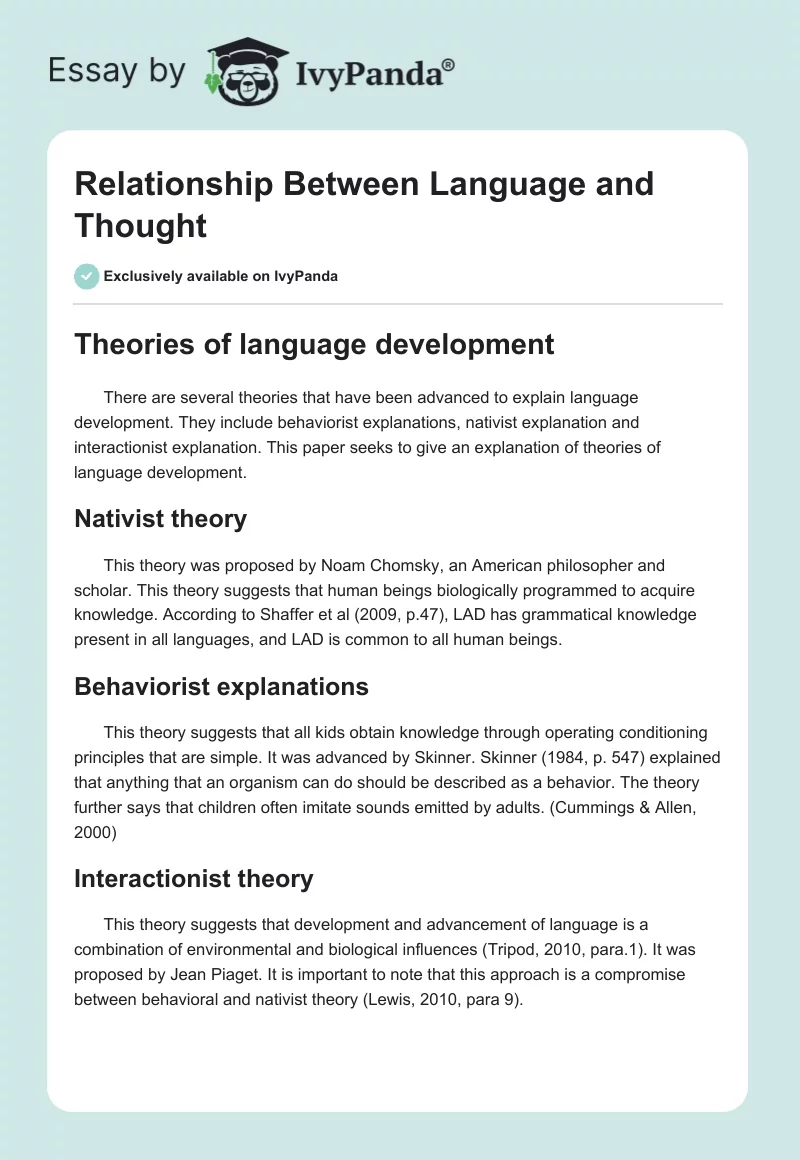Theories of Language Development
There are several theories that have been advanced to explain language development. They include behaviorist explanations, nativist explanation and interactionist explanation. This paper seeks to give an explanation of theories of language development.
- Nativist theory
This theory was proposed by Noam Chomsky, an American philosopher and scholar. This theory suggests that human beings biologically programmed to acquire knowledge. According to Shaffer et al (2009, p.47), LAD has grammatical knowledge present in all languages, and LAD is common to all human beings. - Behaviorist explanations
This theory suggests that all kids obtain knowledge through operating conditioning principles that are simple. It was advanced by Skinner. Skinner (1984, p. 547) explained that anything that an organism can do should be described as a behavior. The theory further says that children often imitate sounds emitted by adults. (Cummings & Allen, 2000) - Interactionist theory
This theory suggests that development and advancement of language is a combination of environmental and biological influences (Tripod, 2010, para.1). It was proposed by Jean Piaget. It is important to note that this approach is a compromise between behavioral and nativist theory (Lewis, 2010, para 9).
Meagan and Jennifer Case
As for Meagan’s case, it is true that parents do not spend much time teaching their kids grammar. Perhaps these parents are so engrossed in their careers that they hardly have time to bond with their growing children. When a child makes grammatical errors while constructing a sentence, parent would ignore, but if the child utters a grammatically correct sentence, the parent will reinforce it.
In Jennifer’s case, Nativity theory suggests that ability of a person to learn languages is separate from overall intelligence. Regarding interactions’ theory, parents do not talk same way to kids as they talk with mature people. Behaviorism theory relies on positive or negative experiences as tools for learning languages.
Relationship between Language and Thought
Language and thought are related because nature of thought is often shaped by language according to linguistic relativity theory (Carrol, 1997, p. 47).
Whorf concluded that Inut people in Canada have a perception that is not same as English. However this has been criticized by other scholars, for example Eleanor Rosch study on Dani people from Papua New Guinea revealed that they did not encounter problem differentiating colors (Rosch, 1978, pp. 328).
According to her, people do not rely much on abstract definitions of categories. Some studies suggest that language can be influenced by color processing such that there is tendency of generalization. For example when some cultures recognize few colors like other cultures (Roberson, Davidoff, Davies & Shapiro, 2004).
Tyler and Jennifer Case
As for Tyler, it is certain that theories have said that language and thought are similar, such that language is used to express thoughts of a person. Benjamin Whorf studied closely Native American languages when he was not at work and concluded that snow had different names however this was later disputed by other researcher.
For Jennifer’s case, It is evident that you disagree with Benjamin Whorf in his study that revealed that people had different names for snow. You have concluded that language and thought are related and you have given an example of Munduruku of Amazonia. I agree that most cultures have particular words for a particular taste for instance sweetness.
Reference List
Carroll, J.(1997). Language, Thought, and Reality: Selected Writings of Benjamin Lee Whorf. Cambridge, Mass.: Technology Press of Massachusetts Institute of Technology.
Cummins, D., & Allen, A. (2000). The evolution of mind. New York: Oxford University Press.
Lewis, s. (2010). How Do Children Learn Language? Theories of language development attempt to explain. Web.
Roberson D., Davidoff J., Davies, I.R. &Shapiro, L.R. (2004).Color categories: evidence for the cultural relativity hypothesis. Cogn psychol. Vol. 50, issue 4.
Rosch, E. (1975).Cognitive representation of semantic categories. Journal of Experimental Psychology. Vol. 3, issue 4, pp. 573-605.
Shaffer, D.R., Kipp, K., Wood, E., & Willoughby, T. (2009). Developmental psychology: Childhood and adolescence, Third Canadian Edition. Toronto: Nelson.
Skinner, F. 1984. The operational analysis of psychological terms. Behavioral and brain sciences. Volume 7, issue 4, pp. 547–581.
Tripod. (2010). The interactionist theory. Web.


